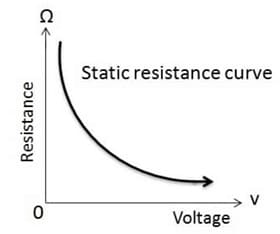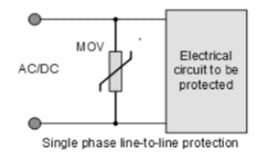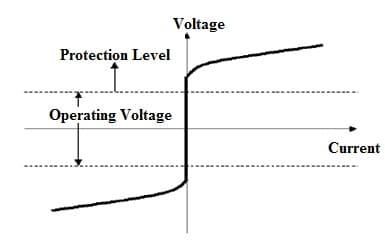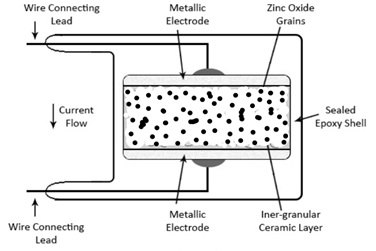Usually, in electronic circuits, we encounter currents and voltages of the order of milliamperes and millivolts. Electronic circuits have very high input impedance and are very sensitive. Our usual methods of over current protection or over-voltage protection are not applicable here. We need a device that is quick and sensitive. A varistor is a device that meets our requirement and controls voltage spikes very effectively thus protecting our circuit. The name of this can be derived from a Variable resistor. Power electronic devices that handle large currents are also protected by varistors. Although many types of varistors are available we shall limit ourselves to Metal oxide varistor commonly known as MOV.
What is Varistor?
Definition: As the name suggests it’s a variable resistor but unlike a rheostat or potentiometer where the viper point is to be physically moved manually or automatically to change the resistance. A varistor is a semiconducting device that becomes conductive after a thresh hold of voltage is reached. Asit is voltage-dependent it is also called voltage-dependent resistor or VDR. It a nonpolar device and can be used for both AC and DC voltages. The various symbols commonly used for varistors are given hereunder.

Varistor Symbols
Varistor Working Principle
To understand the working of a varistor, let us first understand how voltage surges and spikes get created in a circuit/system. Most of the spikes are switching. When we switch off an inductive circuit, a high voltage surge is created due to (L.di/dt.) This surge is created due to the sudden release of energy stored in the inductance. As a thumb rule, it is said that switching on the surge is double the current, and switching off surge is double the voltage. Such surges can also have an adverse effect on all the equipment in the vicinity.
A varistor provides a high resistance path to low voltages and a low resistance path to high voltages. This variation in resistance with voltage is evident from the static resistance curve of the varistor. This characteristic is nonlinear and does not follow Ohm’s law.

Variation with Resistance
In the event of high voltage, there is an inrush of current through the varistor due to reduced resistance which brings back the voltage within the permissible limits. In order to understand its working, let us see the image showing the connectivity of the varistor, which is always parallel to the circuit to be protected. This is done to provide an alternative path to the current so that the voltage is clamped.

Circuit Diagram
Characteristics of a Varistor
The following can be deduced from the VI characteristics.

Characteristics
- The characteristic is identical in reverse and forward direction (the first and third quadrant are similar)
- Beyond the safe/operating zone, the increase in current is abrupt and steep. During this stage, the varistor transits from an insulating state to a conducting state.
- And during the nonconducting state, this behaves like a capacitor. As this starts conducting the maximum surge current that a varistor will take depends on the pulse width and its repetitions. If, it exceeds its limits and is not able to dissipate the heat generated it will overheat and rapture.
Construction of Varistor
The metal oxide varistor (MOV) is made up of insulating material which is zinc oxide (ZnO). This zinc oxide pressed to form a ceramic type of pallet. Only about 10% of some filler material is used for proper junction formation within the rest 90% is zinc oxide.

Construction of Varistor
Construction-wise it has two leads and the outer shell is hard epoxy. It very much looks like a disc type capacitor. The other construction details are given hereunder
It is important to note that a varistor has to be properly selected from a wide range of before use. The main criteria being voltage which should be 15 to 20 percent above the operating voltage.
Advantages and Disadvantages of the Varistor
The advantages are
- It is a very sensitive and fast over-voltage protection device.
- Since it is a bipolar device it can be used for both AC and DC supply.
The disadvantages are
- It is somewhat costly.
- It may get damaged if the rate of rising of voltage and the peak is too high.
- It does not provide any protection against over current.
Applications
The applications of varistor are
- It can be used for the line to line over-voltage protection.
- It can be used for the line to ground over-voltage protection.
- It is excellent for semiconductor protection.
- It can be connected across the make and break contacts to protect the switch against switching surges which otherwise may result in a restrike.
Know more about Clamp Meter.
FAQs
1). How do you test for varistor?
It can be tested by connecting it across a variable voltage source and then finding out the voltage at which it changes its state from insulating to conducting. This voltage should conform to the specifications. Otherwise, in a circuit, we can just see its conductivity with the help of a multimeter
2). Does a varistor have polarity?
It does not have polarity, as it is a bipolar device and can be used both in AC and DC. Its construction is symmetrical.
3). What happens when a varistor fails?
A varistor fails if the rate of rising of voltage and the peak is too high, in that case, the inrush of current will exceed its limits and it will rapture. It may also fail due to degradation and show continuity even at low voltages.
4). How does MOV varistor work?
It works by allowing permissible voltage to pass thru and creating a short circuit if the voltage exceeds its limits, thus providing probation to main equipment.
5) What is a varistor voltage?
Varistor voltage is the voltage beyond which it transits from an insulating state to a conducting state. As a thumb rule, it is the voltage across the varistor if one milliampere current is passed through it.
Thus, this is all about an overview of a varistor and it is inevitable for protecting cost-intensive electronic and electrical equipment and devices. Its proper selection is key to its application. Metal oxide varistor (MOV) has outperformed all other varistors like Zener diodes, etc. and is commonly used nowadays. Here is a question for you, what are the types of varistors?